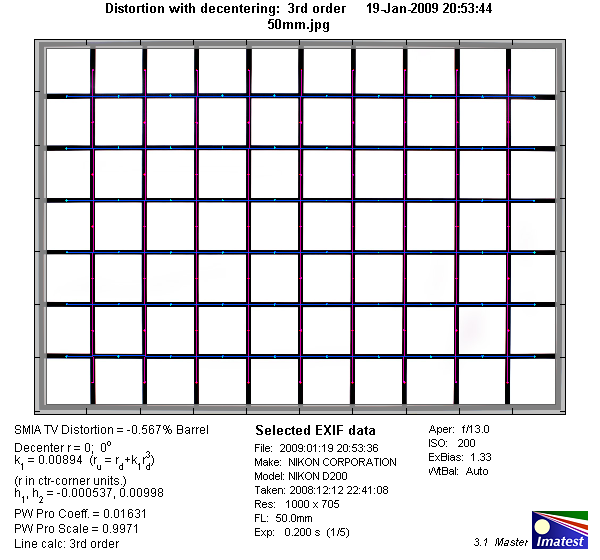|
Nikkor AF-S 50mm f/1.4 G - Review / Test Report - Analysis |
|
Lens Reviews -
Nikon / Nikkor (APS-C)
|
|
Page 2 of 3

Distortion
The lens shows moderate barrel distortion at around 0.6%. This is slightly more than you'd expect from a fix focal lens. However, this is actually typical for fast standard primes and usually not field relevant.

The chart above has a real-world size of about 120x80cm.
Vignetting
As a full frame lens the AF-S 50 enjoys the usual sweet spot advantage on the APS-C test camera. There's a moderate level of vignetting at f/1.4 which is reduced to a negligible degree by stopping down to f/2 or beyond.

MTF (resolution)
The lens delivered very good resolution figures in the center wide open already, reaching excellent levels at f/2.8 and beyond. The borders are somewhat soft wide open (where the lens also lacks a little contrast), but reach very good levels at f/2 and excellent figures at f/4.
The lens showed some focus shift when stopping down (residual spherical aberration).
The tested sample showed a slight decentering issue. Our test procedure allows to mostly work around this issue, however a perfectly centered sample might give a little higher resolution numbers, especially at the borders at wide open aperture.
Please note that the MTF results are not directly comparable across the different systems!
Below is a simplified summary of the formal findings. The chart shows line widths per picture height (LW/PH) which can be taken as a measure for sharpness.
If you want to know more about the MTF50 figures you may check out the corresponding Imatest Explanations
Chromatic Aberrations (CAs)
Chromatic aberrations (color shadows at harsh contrast transitions) are very low at large aperture settings but increase a little when stopping down. However, in the tested aperture range CAs never exceed 1px on the average at the image borders so the problem isn't really field relevant for most subjects.

Bokeh
The quality of the bokeh (out-of-focus blur) is a primary aspect for such a large aperture lens. Unfortunately at wide open aperture the AF-S 50 shows a rather high amount of outlining resulting in a slightly nervous bokeh. From f/2 onwards these outlines disappear and the bokeh smoothens considerably, however highlights in the background remain troubled by LoCAs (see next section).
Thanks to 9 rounded aperture blades, background highlights remain their circular shape throughout the whole aperture range.

Bokeh Fringing / Longitudinal Chromatic Aberrations (LoCA)
LoCAs (non-coinciding focal planes of the various colors) are a common issue with relatively fast glass. As you can
notice below the halos have different colors - magenta (red + blue) in front of the focus point
and green beyond. Truly "apochromatic" lenses don't show LoCAs but these lenses are very rare especially
below 100mm. Unlike lateral lateral CAs, LoCAs cannot easily be fixed in post processing.
Typical for most fast primes the AF-S 50 shows a considerable amount of LoCAs at large aperture settings.
In addition, these shots also show the focus shift when stopping down and demonstrate the slight lack of contrast and sharpness wide open (the latter being emphasized on short subject distances).
|